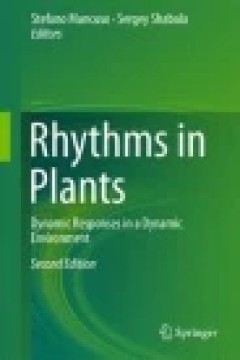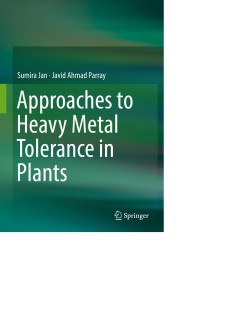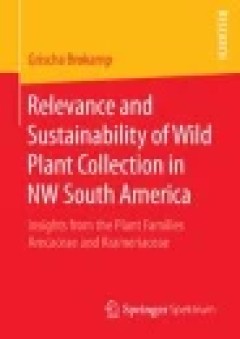Filter by

Rhythms in Plants
This second edition of a well-received book focuses on rhythmic behaviour in plants, which regulates all developmental and adaptive responses and can thus be regarded as quintessential to life itself. The chapters provide a timely update on recent advances in this field and comprehensively summarize the current state of knowledge concerning the molecular and physiological mechanisms behind circ…
- Edition
- -
- ISBN/ISSN
- -
- Collation
- -
- Series Title
- -
- Call Number
- -

Rhizomania
The knowledge of ecology and epidemiology of rhizomania is particularly useful to understand the means and practices able to limit or avoid its further diffusion. Some promising methods of biological control using coexisting and non-pathogenic organisms could potentially help improve the action of the not completely effective genetic resistances. This integrated protection would be valuable, es…
- Edition
- Ed. 1
- ISBN/ISSN
- 978-3-319-30678-0
- Collation
- -
- Series Title
- -
- Call Number
- -
Reproductive Diversity of Plants
The first part of the book presents the evolution of plants starting from photosynthetic cells to topics like Gymnosperms and Angiosperms, including the evolution of the breeding system. Geological and molecular data were used, helping us to show with more details each of the phases presented. Also, specialization of the reproductive systems such as evolution of unissexuality (dioecy and monoe…
- Edition
- Ed. 1
- ISBN/ISSN
- 978-3-319-21254-8
- Collation
- -
- Series Title
- -
- Call Number
- -

Research Progress in Oligosaccharins
Research Progress in Oligosaccharins" is a valuable tool for students and researchers who want to learn about this unique class of bioactive compounds. This book provides important insight into the complex roles of oligosaccharins in plant immunity, physiology, and protection. Oligosaccharins are complex carbohydrates that function in plants as molecular signals to regulate growth, …
- Edition
- Ed. 1
- ISBN/ISSN
- 978-1-4939-3518-5
- Collation
- -
- Series Title
- -
- Call Number
- -

Approaches to Heavy Metal Tolerance in Plants
This book summarizes the development of highly tolerant cultivars via plant breeding, genomics, and proteomic approaches. This book could supplement data for budding researchers by providing extensive ongoing measures to improve the detoxification competence of appropriate species via wide range of plant improvement approaches. It also offers insights into heavy metal signalling,metal chelation…
- Edition
- Ed. 1
- ISBN/ISSN
- 978-981-10-1693-6
- Collation
- XII, 110
- Series Title
- -
- Call Number
- 571.6 JAN a

Relevance and Sustainability of Wild Plant Collection in NW South America
This study focuses on understanding the socio-economic relevance of plant resources collected from the wild and its relation to current patterns of trade and sustainability. Grischa Brokamp reviews and analyzes the current extent of palm trade in northwestern South America, its impact, limitations and future perspective. Indeed there are conflicts between the commercialization of wild plant res…
- Edition
- -
- ISBN/ISSN
- -
- Collation
- -
- Series Title
- -
- Call Number
- -

Chest Surgery
Chest Surgery provides readers with a comprehensive and authoritative text that explains and illustrates all thoracic surgery procedures, with the exception of those on the heart and esophagus. The easy-to-read text is supported by clear, instructive line drawings and intraoperative photographs. The result is a well-illustrated practical guide for the seasoned and novice practitioner alike. The…
- Edition
- -
- ISBN/ISSN
- -
- Collation
- -
- Series Title
- -
- Call Number
- 617.95

Bioresource and Stress Management
This book is a compilation of recent global measures to conserve bio-resources and manage biotic and abiotic stresses. It highlights emerging issues related to agriculture, abiotic and biotic stress factors, ethnic knowledge, climate change and global warming, as well as natural resources and their sustainable management. It also focuses on the consolidated efforts of scientists and academics e…
- Edition
- 1
- ISBN/ISSN
- 978-981-10-0995-2
- Collation
- XV, 276
- Series Title
- -
- Call Number
- 150.6

A General View of the Writings of Linnaeus
Carl Linnaeus (1707–88), father of modern taxonomy, was one of the most important scientists of the eighteenth century. This biography was written by Richard Pulteney (1730–1801), a physician and botanist who greatly admired Linnaeus' methods and aimed to promote them in England. The first edition was published in 1781 and contains a thorough account of the major works of Linnaeus and his u…
- Edition
- William George Maton
- ISBN/ISSN
- 9781139095945
- Collation
- -
- Series Title
- Cambridge Library Collection - Botany and Horticulture
- Call Number
- -

A Garden of Pleasure
Eleanor Vere Boyle (1825–1916), who re-created the gardens of Huntercombe Manor in Berkshire in the 1870s, was a talented artist as well as an author, illustrating both poetry and books for children. Coming from an aristocratic family, and in later life a friend of Queen Alexandra, she produced sketches and watercolours admired by Ruskin and Landseer, and Tennyson and Bulwer Lytton contribute…
- Edition
- -
- ISBN/ISSN
- 9781107741805
- Collation
- -
- Series Title
- Cambridge Library Collection - Botany and Horticulture
- Call Number
- -
 Computer Science, Information & General Works
Computer Science, Information & General Works  Philosophy & Psychology
Philosophy & Psychology  Religion
Religion  Social Sciences
Social Sciences  Language
Language  Pure Science
Pure Science  Applied Sciences
Applied Sciences  Art & Recreation
Art & Recreation  Literature
Literature  History & Geography
History & Geography